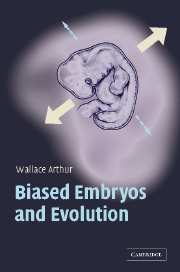Book contents
- Frontmatter
- Contents
- Preface
- Acknowledgements
- 1 The microscopic horse
- 2 What steers evolution?
- 3 Darwin: pluralism with a single core
- 4 How to build a body
- 5 A brief history of the last billion years
- 6 Preamble to the quiet revolution
- 7 The return of the organism
- 8 Possible creatures
- 9 The beginnings of bias
- 10 A deceptively simple question
- 11 Development's twin arrows
- 12 Action and reaction
- 13 Evolvability: organisms in bits
- 14 Back to the trees
- 15 Stripes and spots
- 16 Towards ‘the inclusive synthesis’
- 17 Social creatures
- Glossary
- References
- Index
8 - Possible creatures
Published online by Cambridge University Press: 02 December 2009
- Frontmatter
- Contents
- Preface
- Acknowledgements
- 1 The microscopic horse
- 2 What steers evolution?
- 3 Darwin: pluralism with a single core
- 4 How to build a body
- 5 A brief history of the last billion years
- 6 Preamble to the quiet revolution
- 7 The return of the organism
- 8 Possible creatures
- 9 The beginnings of bias
- 10 A deceptively simple question
- 11 Development's twin arrows
- 12 Action and reaction
- 13 Evolvability: organisms in bits
- 14 Back to the trees
- 15 Stripes and spots
- 16 Towards ‘the inclusive synthesis’
- 17 Social creatures
- Glossary
- References
- Index
Summary
It's time to make another mental leap – from consideration of the actual world that we see around us, with all its actual creatures, to consideration of other possible worlds, with other creatures that might have been. I will argue that a ‘possible creatures’ approach radically alters our view of what determines the direction that evolution takes, and leads to a more inclusive understanding of evolutionary mechanisms generally. Although my approach of thinking about possible creatures has something in common with Stephen Jay Gould's famous metaphor1 of ‘re-playing the tape of life’, the emergent message will be very different. I do not deny the importance of historical contingency upon which Gould focused attention – indeed I will link up with it in due course. But my main message here is to do with interaction, not history.
Our starting point is that evolution is a two-step process: first, novelties appear – as a result of mutation and reprogramming; second, these novelties either do or do not spread through the population (and ultimately the whole species), depending on whether or not they are of increased fitness relative to their predecessor. This is not controversial; rather, all biologists are agreed that both of these steps must happen. The existence of variation – with the presence of two alternative types representing the minimum in this respect – is a prerequisite for evolutionary change. Without heritable variation, natural selection can achieve nothing. This is easy to see if you simply picture a population consisting of many individuals that are both genetically and developmentally identical.
- Type
- Chapter
- Information
- Biased Embryos and Evolution , pp. 87 - 103Publisher: Cambridge University PressPrint publication year: 2004



